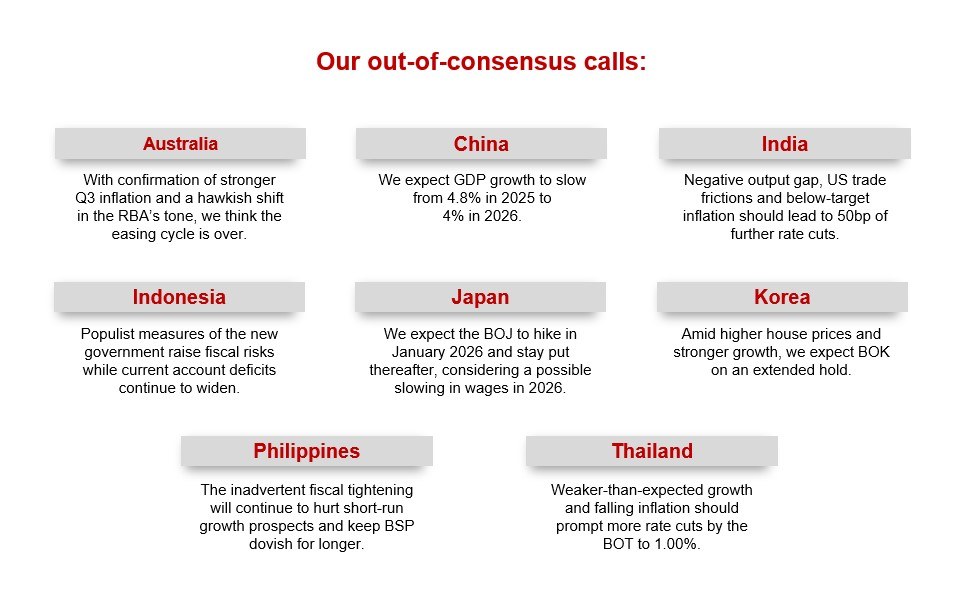A key focus last month was US President Donald Trump’s visit to Asia and the signing of trade and investment deals/frameworks, which prioritize US critical mineral security and advanced tech cooperation while countering trade practices that the US views as unfair. It also sought to strengthen supply
chains against third-party threats. These agreements have important near-term and medium-term implications for Asia.
Lower effective tariff rates and shift in trade flows in the near term
The trade deals will result in lower US effective tariff rates and less trade policy uncertainty, which are incrementally positive for Asia. This is due to lower sectoral tariffs (Korean auto & auto parts), a lower fentanyl-related tariff (China) and a wider list of exemptions and zero-tariffed products (Korea and ASEAN). Our US economists expect the US average effective tariff rate to settle at around 14%, but if these deals are finalized, the effective rate may stop rising or even decline.
Under Trump 2.0, the relative tariff gap between competitor countries matters more than absolute tariff rates. For instance, the lowering of China’s tariff rate by 10 percentage points narrows its tariff gap with the rest of Asia, which will shift trade flow patterns during this truce period. We expect the steep drop in China’s exports to the US to reverse, while its exports to the rest of the world should moderate. The benefit ASEAN economies are enjoying from transshipment should fade, especially for Thailand. Korean battery exports to the US may also slow, but Korean auto exporters should regain some of their lost market share as they now stand at par with Japanese automakers.
China-plus-one shift will continue in the medium term
The US-China truce is unlikely to derail the China-plus-one strategy, as multinational companies are shifting supply chains to mitigate risk. The US-China truce provides both economies some time to develop alternatives, but they remain on the path towards a gradual decoupling. China itself is targeting a shift towards high-tech manufacturing under its 15th five-year plan, so the relocation of low-tech manufacturing by Chinese firms to Asia’s new flying geese
is also likely to continue.
A new critical mineral supply chain
China’s use of its rare earth leverage played an important role in sealing the deal, but a cornerstone of Trump’s Asia tour was signing deals with several other Asian economies to gain access to their critical minerals and rare earths, which are essential for defense, technology and clean energy sectors. China currently accounts for around 70% of global rare earth mining and 99% of refining capacity of heavy rare earths, so it has a clear lead and dominance across the rare earth supply chain. However, according to the United States Geological Survey, while Australia, India and Vietnam together produced only 4.2% of rare earths in 2024, they have about 18% of the rare earth world reserves. Moving from mining to production will take years, but the US strategy in Asia now aims to build resilient critical mineral supply-chain partnerships, gradually reducing its reliance on China.
Reforms by stealth
The silver lining from these trade deals is that Asian economies are pushed to reform, opening their markets to more competition. The US trade agreements cover several non-tariff barriers, pushing for reforms in areas such as state-owned enterprises, import licensing procedures, recognition of international standards, agriculture, intellectual property, patent backlogs, and customs modernization, among others. These reforms, although serving US commercial interests, represent genuine deregulation to increase efficiency that will also benefit Asia.
Asia is hedging itself
Even as Asian economies are negotiating trade deals with the US, and the ASEAN-China Free Trade Area (ACFTA) 3.0 was signed on 28 October, economies are hedging against overdependence on any single economic partner. Several economies are simultaneously pursuing multiple Free Trade Agreement negotiations across different regions. For example, ASEAN is improving intra-regional ties, and several Asian countries are negotiating trade agreements with the EU, Canada, Gulf states and Latin America.
Diversified trade relationships should provide insurance against supply-chain disruptions and reduce trade vulnerability to single-country economic coercion. However, as every country diversifies its exports, competition in third markets is also set to intensify.
For more on our growth projections, read our full report.






